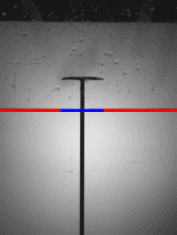Impact on water surfaces
A spectacular example of free surface flow is the impact of a solid object on a liquid: At impact a “crown” splash is created and a surface cavity (void) emerges which immediately starts to collapse due to the hydrostatic pressure of the surrounding liquid. Eventually the cavity closes in a single point about halfway down its length and shoots out a fast and extremely slender water jet. Here we impact thin circular discs a few centimeters in radius with velocities of a few meters per second. Combining high-speed imaging with sophisticated boundary-integral simulations we elucidate various aspects of this fascinating process.
Besides the intrinsic interest of understanding such a familiar and immensely frequent phenomenon, impacts can be of enormous practical importance in, for example, climate research: As every day billions of raindrops hit the surface of the ocean, each of them entrains a small air bubble. This constitutes the main mechanism of carbon dioxide exchange between the atmosphere and the sea. Furthermore, the oscillations of these bubbles are a major source of underwater noise and as such are crucial for sonar research. In medical physics, scientists are currently seeking ways to use thin liquid jets similar to those created during solid object impact for drug delivery through cell membranes or through a patient's skin.
See the links below for details about the different subtopics.

See the links below for details about the different subtopics:
Info: Devaraj van der Meer
Researchers: Stephan Gekle, Oscar Enríquez, Ivo Peters, Detlef Lohse, Andrea Prosperetti, Devaraj van der Meer.
Collaborators: José Gordillo Arias de Saavedra
Embedding: JMBC
Sponsors: FOM
